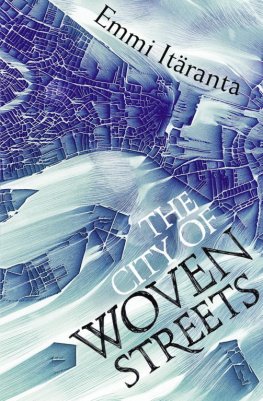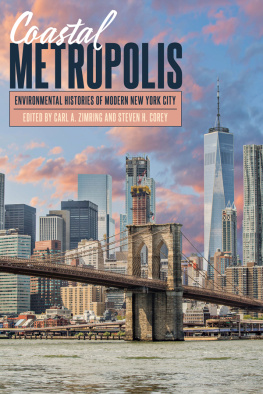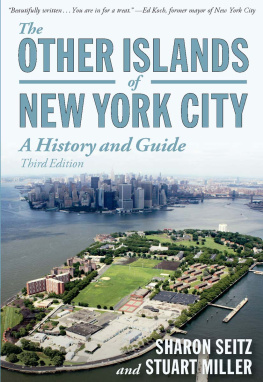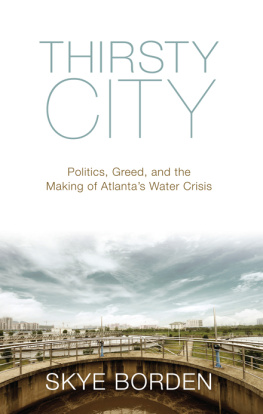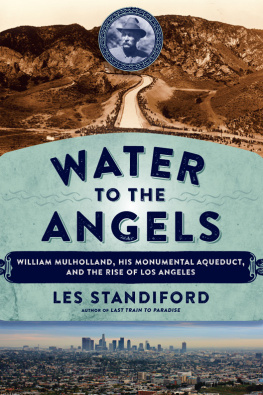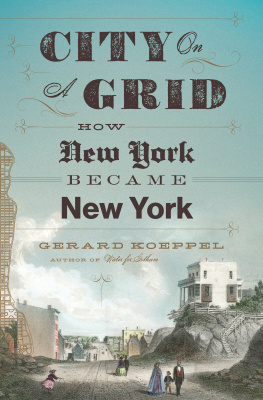At Sea in the City
NEW YORK FROM
THE WATERS EDGE

by William Kornblum
with a foreword by Pete Hamill
illustrations by Oliver Williams

Algonquin Books
of Chapel Hill
Published by
ALGONQUIN BOOKS OF CHAPEL HILL
Post Office Box 2225
Chapel Hill, North Carolina 27515-2225
a division of
Workman Publishing
225 Varick Street
New York, New York 10014
2002 by William Kornblum.
Foreword 2002 by Pete Hamill.
Illustrations 2002 by Oliver Williams
All rights reserved.
Library of Congress Cataloging-in-Publication Data is available.
E-book ISBN 978-1-56512-705-0
For Noah, Eve, and Johanna
CONTENTS
Acknowledgments
ILL NEVER ADEQUATELY THANK all the friends and colleagues who made this book so enjoyable to live and to write. I fear that any listing would be partial at best. My real dream is to take everyone sailing, and with time and some luck, Susan and I may accomplish that happy feat. For now, let me formally thank the people from Algonquin Books. Editor Duncan Murrell picked out this manuscript from the unsolicited pile and showed me how to realize my hopes for it. Elisabeth Scharlatt, Algonquins publisher, was the most creative and professional book adviser a writer could ask for. Thanks also to Elisabeths staff: Lynn Strong, copy editor; Dana Stamey, managing editor; Anne Winslow, designer; and Craig Popelars, marketing director. Finally, mapmaker and Yankee fan Oliver Williams was a joy to work with, especially during the 2001 World Series.
My family members were the earliest, if most biased, believers in this book. Eve read passages to friends and convinced me to put it out in the world. Noah and Johanna gave me endless encouragement and never hesitated to come sailing. Susan lived every moment of it with me, which was the greatest blessing, and since our sailing adventures continue, it still is.
Foreword
Im a New Yorker, born and bred, and have lived most of my life in the company of rivers and the sea. Each day of my childhood in a top floor flat of a Brooklyn tenement, I could see the harbor. Sometimes the windows were rimed with winter ice. Sometimes they were open to sultry August. But there was the harbor, with the Statue of Liberty like a green toy and the skyline off to the right and Staten Island and New Jersey reduced to distant brown smears. From those windows, and from our rooftops, we could see the troopships coming home after the war had ended in Europe, while foghorns issued baritone announcements of triumph, and ten thousand church bells pealed, and the people on those rooftops roared their welcome. Look, theres the Queen Mary. And that ship, the white one, what is that?
After all the young men were home, embraced on our piers by those who loved them, and then dispersed through our city and throughout the United States, we saw the ships of peace: dark muscular freighters, immense ocean liners, all nudged and shoved and guided through the channels by what seemed to be hundreds of tough, ropy little tugboats. The harbor was always dense with movement. We all knew that we lived in a port.
But there were other currents moving in our young lives, and they were about more than simple geography. My parents were immigrants from Belfast, in Northern Ireland, and my mothers father, Peter Devlin, was a man who went to sea. My sister still has some of his papers, sketching distant journeys to Rangoon and Yokohama through the distant seas of Joseph Conrad. Peter Devlin rose to become an engineer for the Great White Fleet, charged with hauling bananas from Central America to the tables of Europe. When he married and had two children, he decided it was time to leave the sea and settled in Brooklyn to work for the Cunard Line. There, in 1916, when my mother was five, he was killed in an accident. His small family returned to Ireland. But my mother never could escape the pull of New York.
And so she helped us see New York for what it was then: a city of rivers and bridges and a great welcoming harbor. From our rooftop, she could see the place where her father died. She could see Ellis Island, too, and the spires of Manhattan. She saw all of this with an immigrants sense of pure human wonder, and she passed it to us. Her tutelage was not a matter of mere words. She took usmy brother Tom, my sister Kathleenon long walks. On some days, we walked upon the Brooklyn Bridge high over the East River, while she explained that it wasnt really a river at all, it was an estuary, and the water flowed south and north at the same time, uptown and down. Way up there at the top of the estuary, she said, there was a place called Hell Gate where old wooden ships were smashed into splinters. And she loved that bridge itself. For us, it was an astonishment, soaring, sweeping, its cables singing in the wind, put there by amazing men.
The bridge led us into lower Manhattan, and our wanderings took many directions. Sometimes we went to the Battery to look out upon the immensity of the harbor. During the American Revolution, the harbor had frozen solid, and British cavalry crossed the ice with horses and cannon, trying to finish off George Washington. He would live to see the British sail away forever on November 25, 1783, waiting high in the ruined city until word came that the last ship had sailed. Then Washington led his battered, injured, and triumphant army in the first great parade in our history. For almost a century, the event was celebrated as Evacuation Day. And right there, said my mother, pointing at St. Pauls Chapel on Broadway and Fulton Street: right there George Washington went to pray.
On some days, we would take the subway to Times Square and walk west to see the ruined hulk of a liner called the Normandie. It had burned at its pier in February 1942, and there were dark rumors of Nazi sabotage, which appealed to my melodramatic imagination. I was then six. The once luxurious liner lay on its side like some immense wounded sea creature, and we asked my mother, over and over again, to go to see the Normandie, and over and over again she took us, in good weather and bad. Burners and welders worked over the hulk, taking it apart for scrap. Each time we saw her, there was less of her. Today, when I think about wartime New York, I still see the Normandie.
As a young man, I went to work as a reporter for the New York Post, which was then at 75 West Street, across the street from those United Fruit piers. The Post was an afternoon newspaper, and it was believed that afternoon papers must be located along the rivers, south of Canal Street. From such bases, they could avoid midtown traffic by using the great bridges to race to the boroughs with their early editions. Up the street from the Post was the New York World-Telegram & Sun, where Joseph Mitchell (mentioned fondly in this book) worked alongside A. J. Liebling and H. Allen Smith in the years before the war. Mitchells pieces for the New Yorker thrilled most newspapermen and were filled with deep, loving knowledge of our many waters. He was from North Carolina, not New York, but from his daily labors on our waterfront, he put New York deep in his bones.
I usually worked nights, still known then as the lobster shift, and when the shift ended at eight in the morning, I set out with a few hollow-eyed colleagues in search of food. Usually we went to Sloppy Louies, around the horn (as we called the tip of Manhattan) on South Street, facing the East River. The old-timers still called the Hudson the North River, a tradition dating back to the seventeenth-century Dutch (the South River was in Maryland). So the North River was on the west side of Manhattan, and South Street was on the east side, and all of it made absolute sense over fresh fish and mugs of beer.


